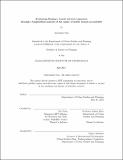Evaluating Beijing’s transit network expansion through a longitudinal analysis of the equity of public transit accessibility
Author(s)
Guo, Alexander
DownloadThesis PDF (56.02Mb)
Advisor
Yang, Xin
Zhao, Jinhua
Terms of use
Metadata
Show full item recordAbstract
China’s rise as a global economic powerhouse brings with it enormous challenges to its ever-expanding megacities. Beijing, in particular, has experienced exponential growth in the last few decades, causing serious problems with traffic congestion, air quality, and sprawl. Planners have increasingly invested in public transit, particularly in subway and commuter rail, to solve these issues. This thesis investigates the effectiveness of such investment on the overall accessibility and equity of accessibility of public transit, for the past, present, and future. Using global satellite datasets for trip generation and a comprehensive graph of Beijing’s full, multi-modal transit system, including bus, subway, and commuter rail, this study calculates accessibility at a fine level and equity at a city-wide level, finding that although Beijing’s transit system is overall equitable, equity improvements from rural transit infrastructure are negated by increased decentralization of the city’s population and economic activities in recent years. As such, although equity of transit accessibility (ETA) has improved in general since 2006, this phenomenon has caused a noticeable deterioration in ETA recently and into the future, and serves as a strong argument to either reduce urban sprawl or accelerate Beijing’s transformation into a polycentric city with multiple, high-density urban cores linked by high-speed commuter rail.
Date issued
2021-06Department
Massachusetts Institute of Technology. Department of Urban Studies and PlanningPublisher
Massachusetts Institute of Technology